Spatiotemporal Variations in Light Precipitation Events in the Yellow River Basin, China, and Relationships with Large-Scale Atmospheric Circulation Patterns
Abstract
:1. Introduction
2. Materials and Methods
2.1. Study Area and Data Description
2.2. Methods
2.2.1. Definition of Light Precipitation Events
2.2.2. Trend Analysis
2.2.3. Correlation Analysis
3. Results and Discussion
3.1. Spatiotemporal Variations in Annual Precipitation
3.2. Spatiotemporal Variations in Light Precipitation
3.2.1. Spatiotemporal Variations in G1 Light Precipitation Events
3.2.2. Spatiotemporal Variations in G2 Light Precipitation Events
3.2.3. Spatiotemporal Variations in G3 Light Precipitation Events
3.2.4. Spatiotemporal Variations in G4 Light Precipitation Events
3.2.5. Spatiotemporal Variations in G5 Light Precipitation Events
3.3. The Spatial Distribution of the Light Precipitation Assessment Index
3.4. Mutation Analysis of the Light Precipitation Events
3.5. Relationships between Large-Scale Atmospheric Circulation Patterns, Elevation, and Light Precipitation
4. Discussion
5. Conclusions
Author Contributions
Funding
Institutional Review Board Statement
Informed Consent Statement
Data Availability Statement
Conflicts of Interest
References
- Mohammadi, B.; Vaheddoost, B.; Mehr, A.D. A spatiotemporal teleconnection study between Peruvian precipitation and oceanic oscillations. Quat. Int. 2020, 565, 1–11. [Google Scholar] [CrossRef]
- IPCC. Climate Change 2021: The Physical Science Basis. Contribution of Working Group I to the Sixth Assessment Report of the Intergovernmental Panel on Climate Change; Cambridge Press: Cambridge, UK, 2021. [Google Scholar]
- Guan, Y.; Zheng, F.; Zhang, X.; Wang, B. Trends and variability of daily precipitation and extremes during 1960–2012 in the Yangtze River Basin, China. Int. J. Clim. 2017, 37, 1282–1298. [Google Scholar] [CrossRef]
- Bettolli, M.L.; Solman, S.A.; da Rocha, R.P.; Llopart, M.; Gutierrez, J.M.; Fernández, J.; Olmo, M.E.; Lavin-Gullon, A.; Chou, S.C.; Rodrigues, D.C.; et al. The CORDEX Flagship Pilot Study in southeastern South America: A comparative study of statistical and dynamical downscaling models in simulating daily extreme precipitation events. Clim. Dyn. 2021, 56, 1589–1608. [Google Scholar] [CrossRef]
- Groisman, P.Y.; Bulygina, O.N.; Yin, X.; Vose, R.S.; Gulev, S.K.; Hanssen-Bauer, I.; Førland, E. Recent changes in the frequency of freezing precipitation in North America and Northern Eurasia. Environ. Res. Lett. 2016, 11, 045007. [Google Scholar] [CrossRef]
- Ye, H.; Fetzer, E.J.; Wong, S.; Lambrigtsen, B.H. Rapid decadal convective precipitation increase over Eurasia during the last three decades of the 20th century. Sci. Adv. 2017, 3, e1600944. [Google Scholar] [CrossRef] [Green Version]
- Chernokulsky, A.; Kozlov, F.; Zolina, O.; Bulygina, O.N.; Mokhov, I.I.; Semenov, V.A. Observed changes in convective and stratiform precipitation in Northern Eurasia over the last five decades. Environ. Res. Lett. 2019, 14, 045001. [Google Scholar] [CrossRef]
- Wen, G.; Huang, G.; Hu, K.; Qu, X.; Tao, W.; Gong, H. Changes in the characteristics of precipitation over northern Eurasia. Arch. Meteorol. Geophys. Bioclimatol. Ser. B 2014, 119, 653–665. [Google Scholar] [CrossRef]
- Wen, G.; Huang, G.; Tao, W.; Liu, C. Observed trends in light precipitation events over global land during 1961–2010. Arch. Meteorol. Geophys. Bioclimatol. Ser. B 2016, 125, 161–173. [Google Scholar] [CrossRef]
- Liu, B.; Xu, M.; Henderson, M.; Qi, Y. Observed trends of precipitation amount, frequency, and intensity in China, 1960–2000. J. Geophys. Res. Atmos. 2005, 110, D08103. [Google Scholar] [CrossRef]
- Wu, J.; Zhang, L.; Zhao, D.; Tang, J. Impacts of warming and water vapor content on the decrease in light rain days during the warm season over eastern China. Clim. Dyn. 2015, 45, 1841–1857. [Google Scholar] [CrossRef]
- Fu, J.; Qian, W.; Lin, X.; Chen, D. Trends in graded precipitation in China from 1961 to 2000. Adv. Atmos. Sci. 2008, 25, 267–278. [Google Scholar] [CrossRef]
- Michaels, P.J.; Knappenberger, P.C.; Frauenfeld, O.W.; Davis, R.E. Trends in precipitation on the wettest days of the year across the contiguous USA. Int. J. Clim. 2004, 24, 1873–1882. [Google Scholar] [CrossRef]
- Liu, B.; Xu, M.; Henderson, M. Where have all the showers gone? Regional declines in light precipitation events in China, 1960–2000. Int. J. Clim. 2011, 31, 1177–1191. [Google Scholar] [CrossRef]
- Wu, J.; Ling, C.; Zhao, D.; Zhao, B. A counterexample of aerosol suppressing light rain in Southwest China during 1951–2011. Atmos. Sci. Lett. 2016, 17, 487–491. [Google Scholar] [CrossRef]
- Jiang, Z.; Shen, Y.; Ma, T.; Zhai, P.; Fang, S. Changes of precipitation intensity spectra in different regions of mainland China during 1961–2006. J. Meteorol. Res. 2014, 28, 1085–1098. [Google Scholar] [CrossRef]
- Fu, C.; Dan, L. Trends in the different grades of precipitation over South China during 1960–2010 and the possible link with anthropogenic aerosols. Adv. Atmos. Sci. 2014, 31, 480–491. [Google Scholar] [CrossRef]
- Wu, J.; Zhang, L.; Gao, Y.; Zhao, D.; Zha, J.; Yang, Q. Impacts of cloud cover on long-term changes in light rain in Eastern China. Int. J. Clim. 2017, 37, 4409–4416. [Google Scholar] [CrossRef]
- Li, K.F.; Cao, L.G.; Zhou, Z.C.; Jiao, L.; Wang, N.; Liu, R. Characteristics and Cause Analysis of Variations in Light Precipitation Events in the Central and Eastern Tibetan Plateau, China, During 1961–2019. Chin. Geogr. Sci. 2022, 32, 155–173. [Google Scholar] [CrossRef]
- Qian, Y.; Gong, D.; Leung, R. Light rain events change over North America, Europe, and Asia for 1973–2009. Atmos. Sci. Lett. 2010, 11, 301–306. [Google Scholar] [CrossRef]
- Huang, G.; Wen, G. Spatial and temporal variations of light rain events over China and the mid-high latitudes of the Northern Hemisphere. Chin. Sci. Bull. 2013, 58, 1402–1411. [Google Scholar] [CrossRef] [Green Version]
- Qian, Y.; Gong, D.Y.; Fan, J.W.; Leung, L.R.; Bennartz, R.; Chen, D.; Wang, W. Heavy pollution suppresses light rain in China: Observations and modeling. J. Geophys. Res. Atmos. 2009, 114, D00K02. [Google Scholar] [CrossRef]
- Zhang, Y.; Liu, C.; You, Q.; Chen, C.; Xie, W.; Ye, Z.; Li, X.; He, Q. Decrease in light precipitation events in Huai River Eco-economic Corridor, a climate transitional zone in eastern China. Atmos. Res. 2019, 226, 240–254. [Google Scholar] [CrossRef]
- Deng, Y.; Jiang, W.; He, B.; Chen, Z.; Jia, K. Change in Intensity and Frequency of Extreme Precipitation and its Possible Teleconnection with Large-Scale Climate Index Over the China from 1960 to 2015. J. Geophys. Res. Atmos. 2018, 123, 2068–2081. [Google Scholar] [CrossRef]
- Zhang, K.; Yao, Y.; Qian, X.; Wang, J. Various characteristics of precipitation concentration index and its cause analysis in China between 1960 and 2016. Int. J. Clim. 2019, 39, 4648–4658. [Google Scholar] [CrossRef]
- Xiao, M.; Zhang, Q.; Singh, V.P. Spatiotemporal variations of extreme precipitation regimes during 1961-2010 and possible teleconnections with climate indices across China. Int. J. Clim. 2017, 37, 468–479. [Google Scholar] [CrossRef]
- Xiao, M.; Zhang, Q.; Singh, V.P. Influences of ENSO, NAO, IOD and PDO on seasonal precipitation regimes in the Yangtze River basin, China. Int. J. Clim. 2015, 35, 3556–3567. [Google Scholar] [CrossRef]
- Zhang, K.; Dai, S.; Dong, X. Dynamic Variability in Daily Temperature Extremes and Their Relationships with Large-scale Atmospheric Circulation during 1960–2015 in Xinjiang, China. Chin. Geogr. Sci. 2020, 30, 233–248. [Google Scholar] [CrossRef] [Green Version]
- Yang, D.; Li, C.; Hu, H.; Lei, Z.; Yang, S.; Kusuda, T.; Koike, T.; Musiake, K. Analysis of water resources variability in the Yellow River of China during the last half century using historical data. Water Resour. Res. 2004, 40, W06502. [Google Scholar] [CrossRef]
- Wang, L.; Zhang, J.; Shu, Z.; Wang, Y.; Bao, Z.; Liu, C.; Zhou, X.; Wang, G. Evaluation of the Ability of CMIP6 Global Climate Models to Simulate Precipitation in the Yellow River Basin, China. Front. Earth Sci. 2021, 9, 751974. [Google Scholar] [CrossRef]
- Kexin, Z.; Xiaogang, D.; Jiaoting, P.; Zhihua, S.; Yanhong, Z. Analysis of changes in thermal growing season and their relationships with atmospheric teleconnection patterns for the Yellow River basin in China. Phys. Geogr. 2021, 42, 183–198. [Google Scholar] [CrossRef]
- Mehr, A.D.; Hrnjica, B.; Bonacci, O.; Haghighi, A.T. Innovative and successive average trend analysis of temperature and precipitation in Osijek, Croatia. Arch. Meteorol. Geophys. Bioclimatol. Ser. B 2021, 145, 875–890. [Google Scholar] [CrossRef]
- Villarini, G.; Smith, J.A.; Vecchi, G. Changing Frequency of Heavy Rainfall over the Central United States. J. Clim. 2013, 26, 351–357. [Google Scholar] [CrossRef]
- Liu, Y.; Tang, X.; Sun, Z.; Zhang, J.; Wang, G.; Jin, J.; Wang, G. Spatiotemporal precipitation variability and potential drivers during 1961–2015 over the Yellow River Basin, China. Weather 2019, 74, S32–S39. [Google Scholar] [CrossRef] [Green Version]
- Zhang, K.-X.; Pan, S.-M.; Zhang, W.; Xu, Y.-H.; Cao, L.-G.; Hao, Y.-P.; Wang, Y. Influence of climate change on reference evapotranspiration and aridity index and their temporal-spatial variations in the Yellow River Basin, China, from 1961 to 2012. Quat. Int. 2015, 380–381, 75–82. [Google Scholar] [CrossRef]
- Dore, M.H. Climate change and changes in global precipitation patterns: What do we know? Environ. Int. 2005, 31, 1167–1181. [Google Scholar] [CrossRef]
- Liu, Q.; Yang, Z.; Cui, B. Spatial and temporal variability of annual precipitation during 1961–2006 in Yellow River Basin, China. J. Hydrol. 2008, 361, 330–338. [Google Scholar] [CrossRef]
- Qian, W.; Fu, J.; Yan, Z. Decrease of light rain events in summer associated with a warming environment in China during 1961–2005. Geophys. Res. Lett. 2007, 34, L11705. [Google Scholar] [CrossRef]
- Zongxing, L.; He, Y.; Wang, P.; Theakstone, W.H.; An, W.; Wang, X.; Lu, A.; Zhang, W.; Cao, W. Changes of daily climate extremes in southwestern China during 1961–2008. Glob. Planet. Chang. 2012, 80–81, 255–272. [Google Scholar] [CrossRef]

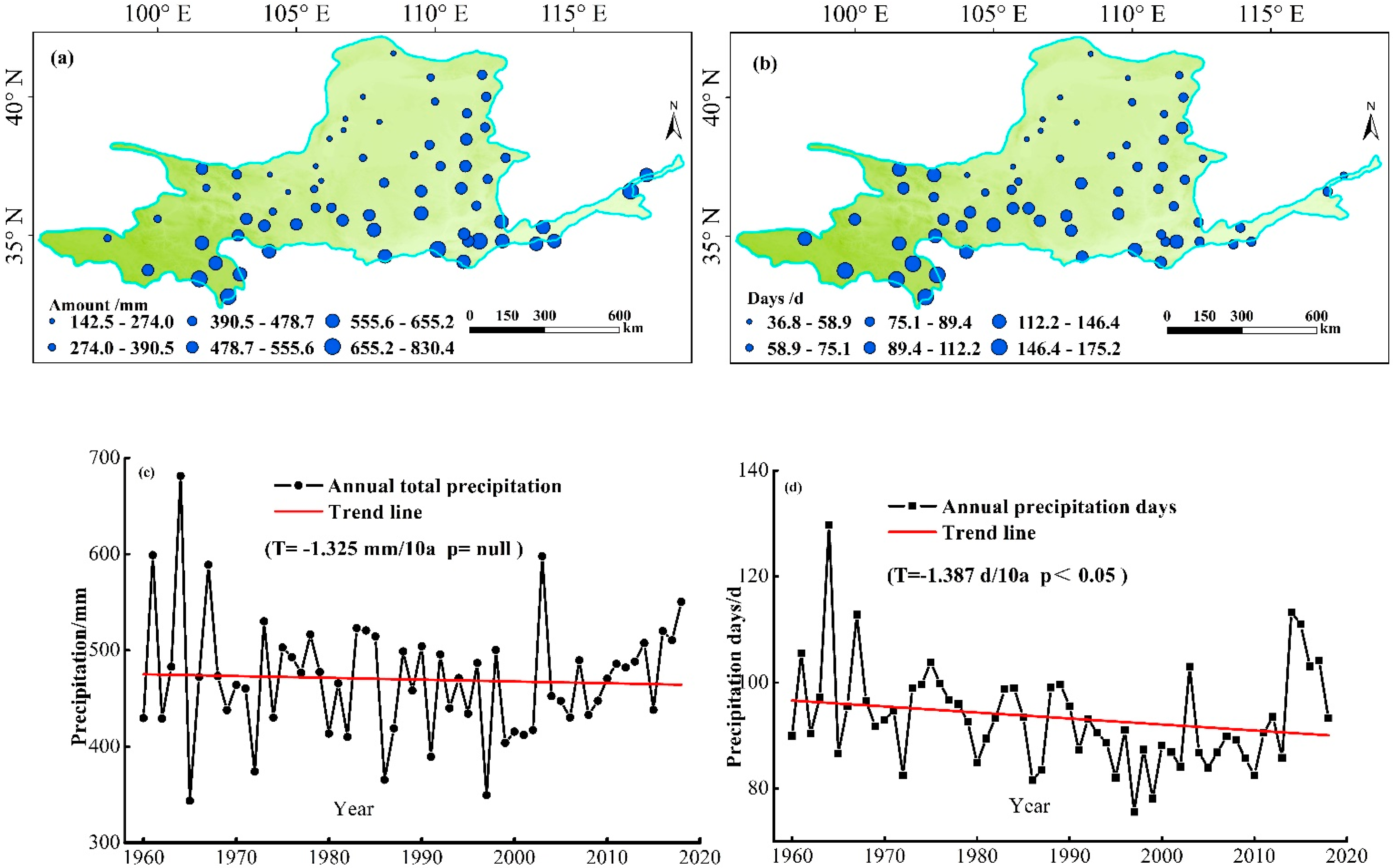
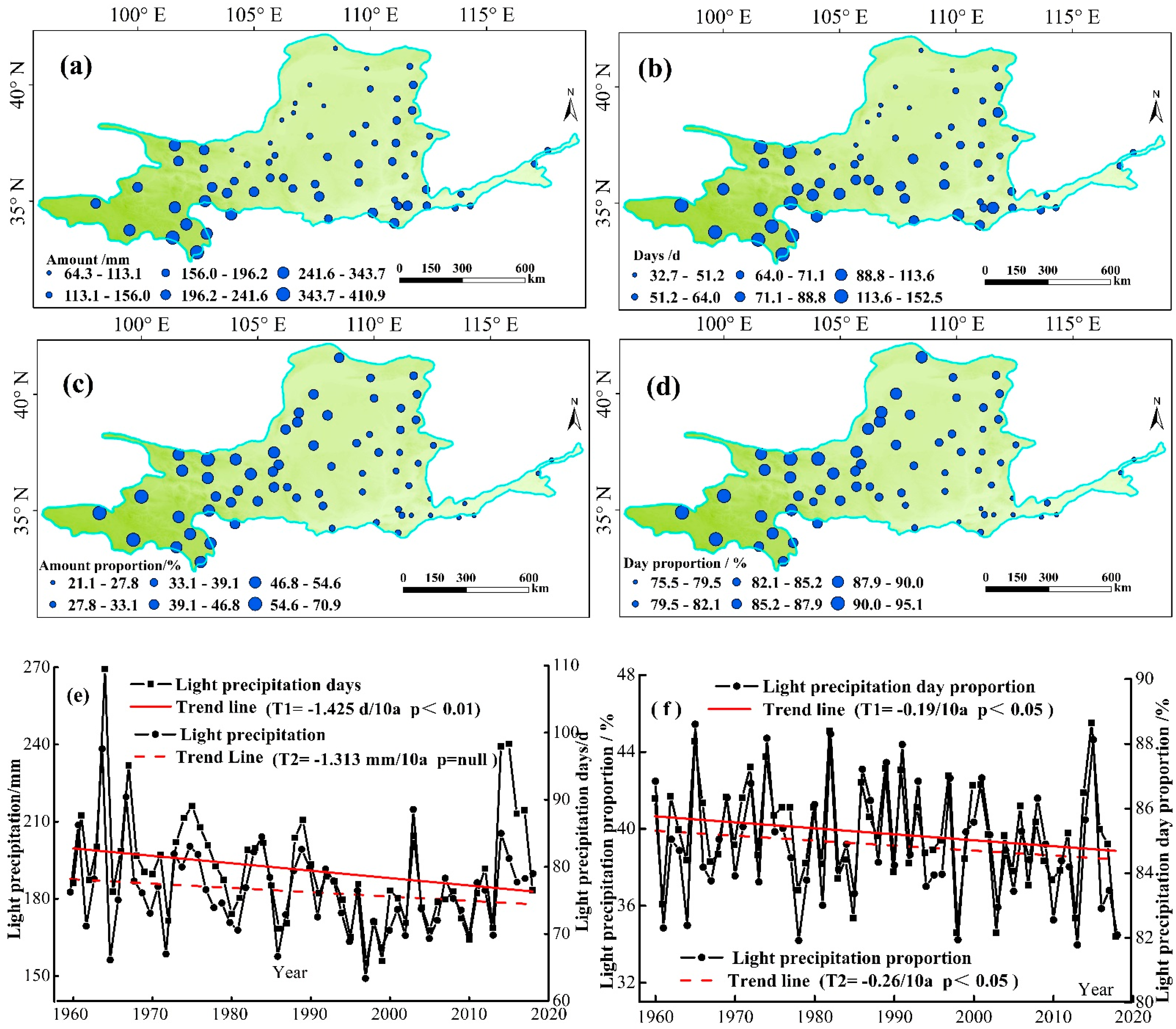
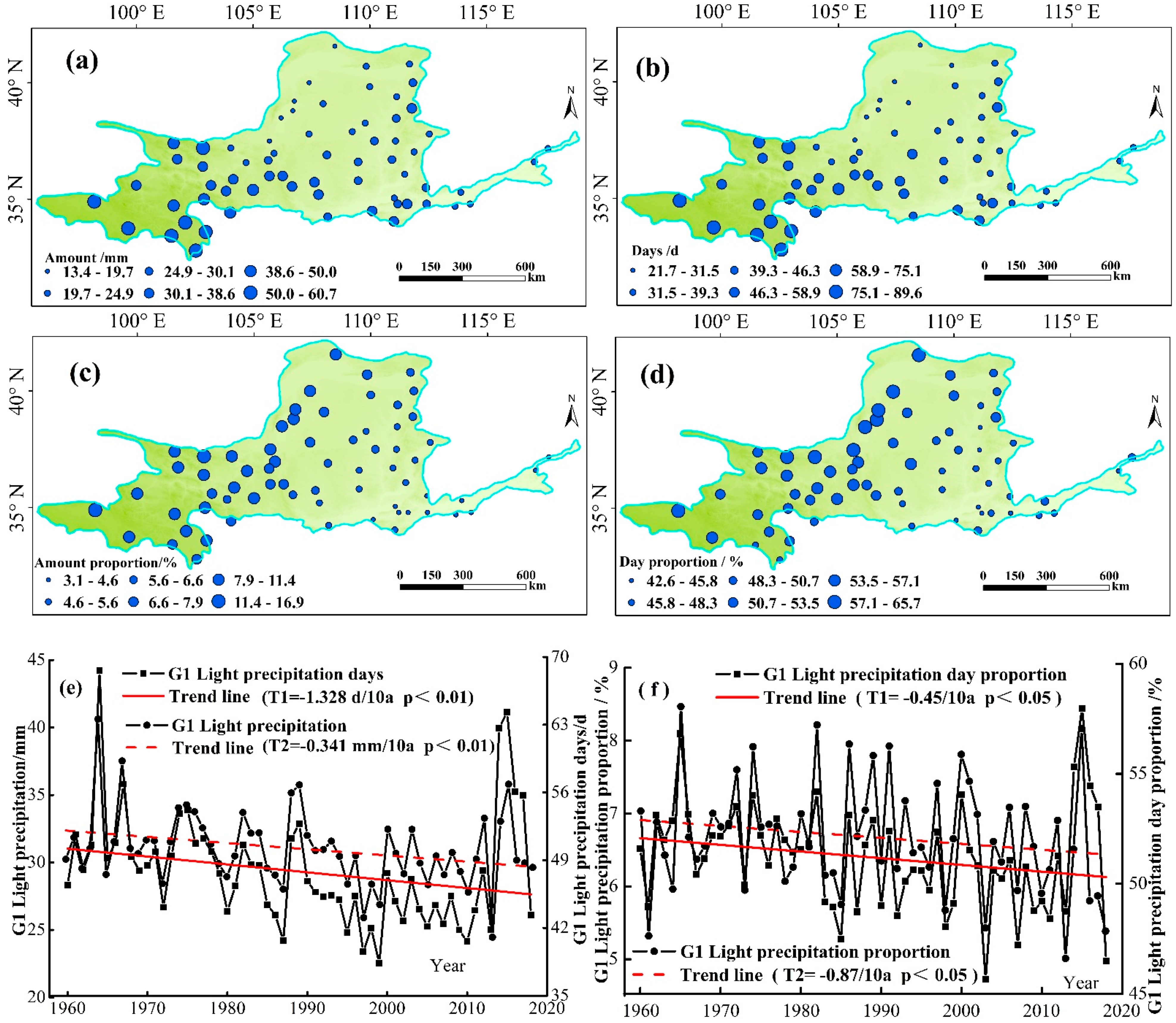
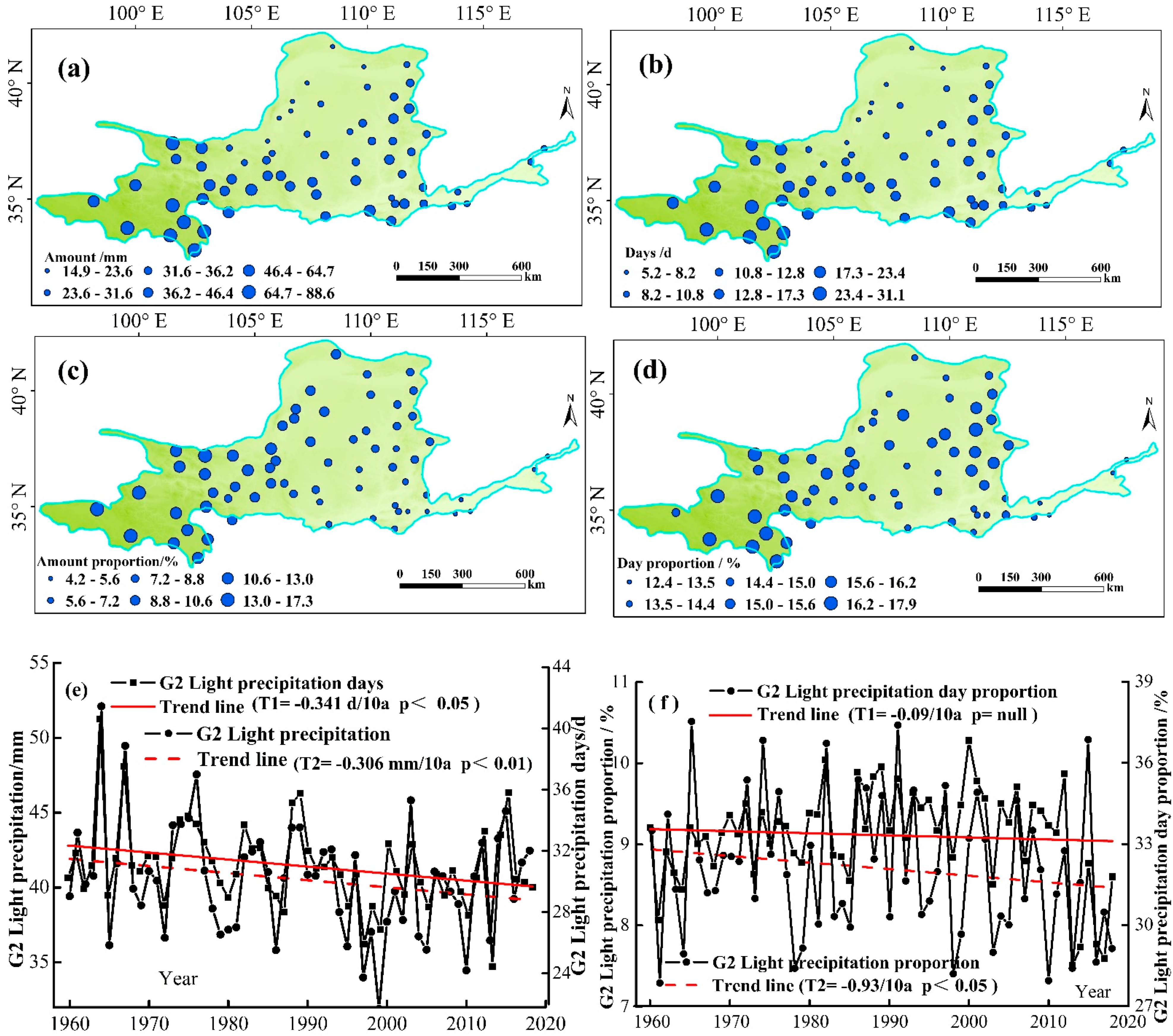
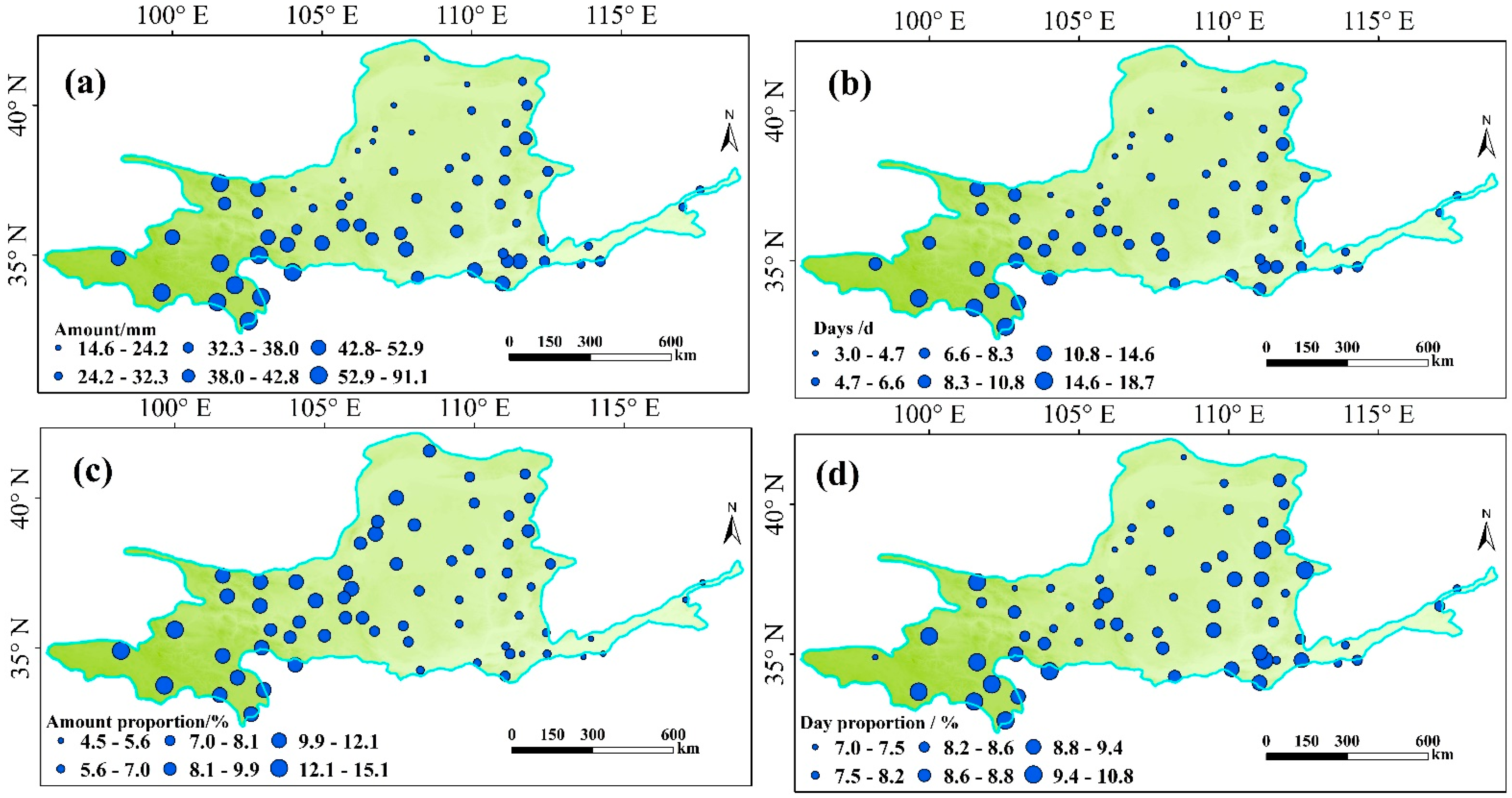


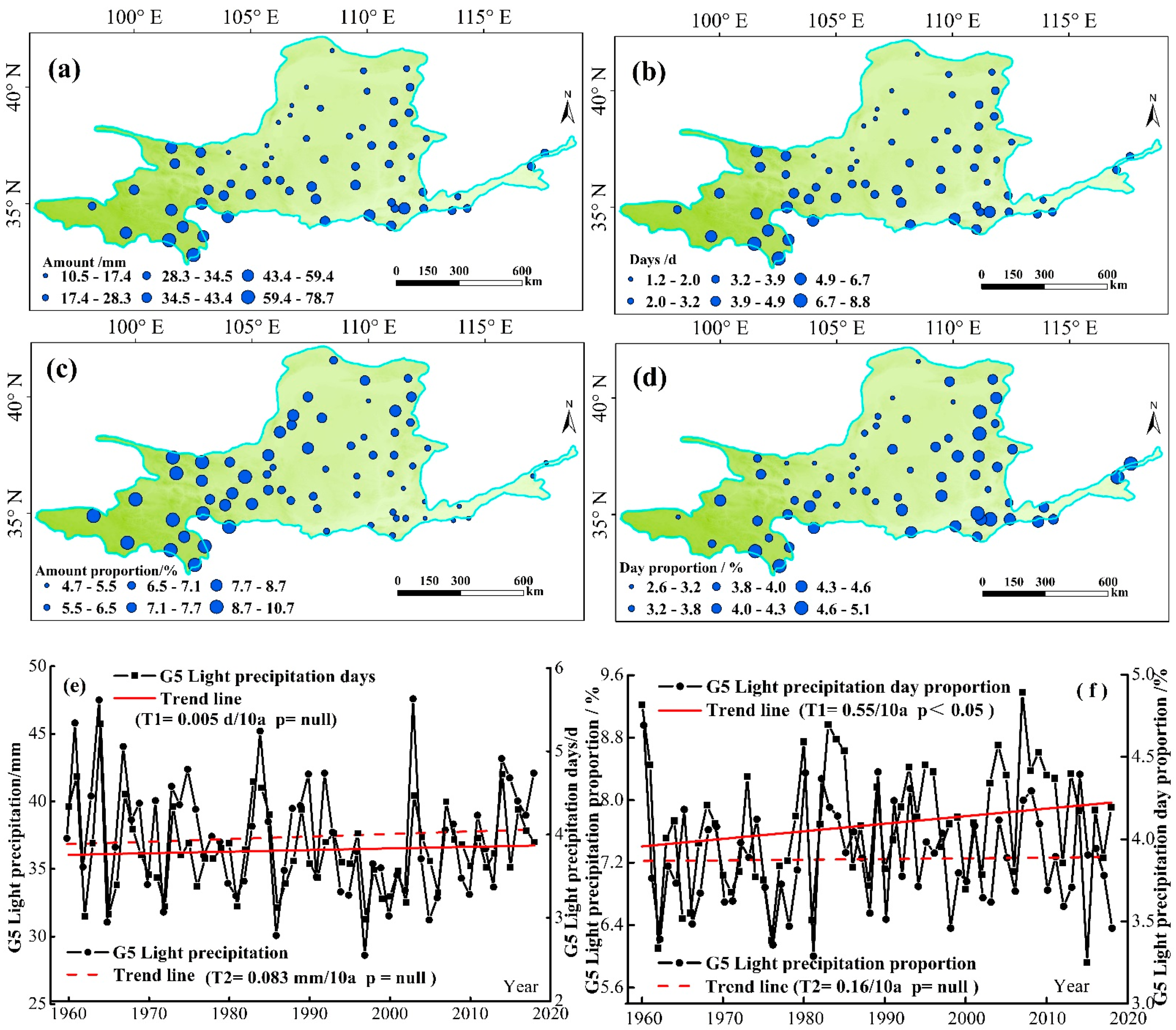
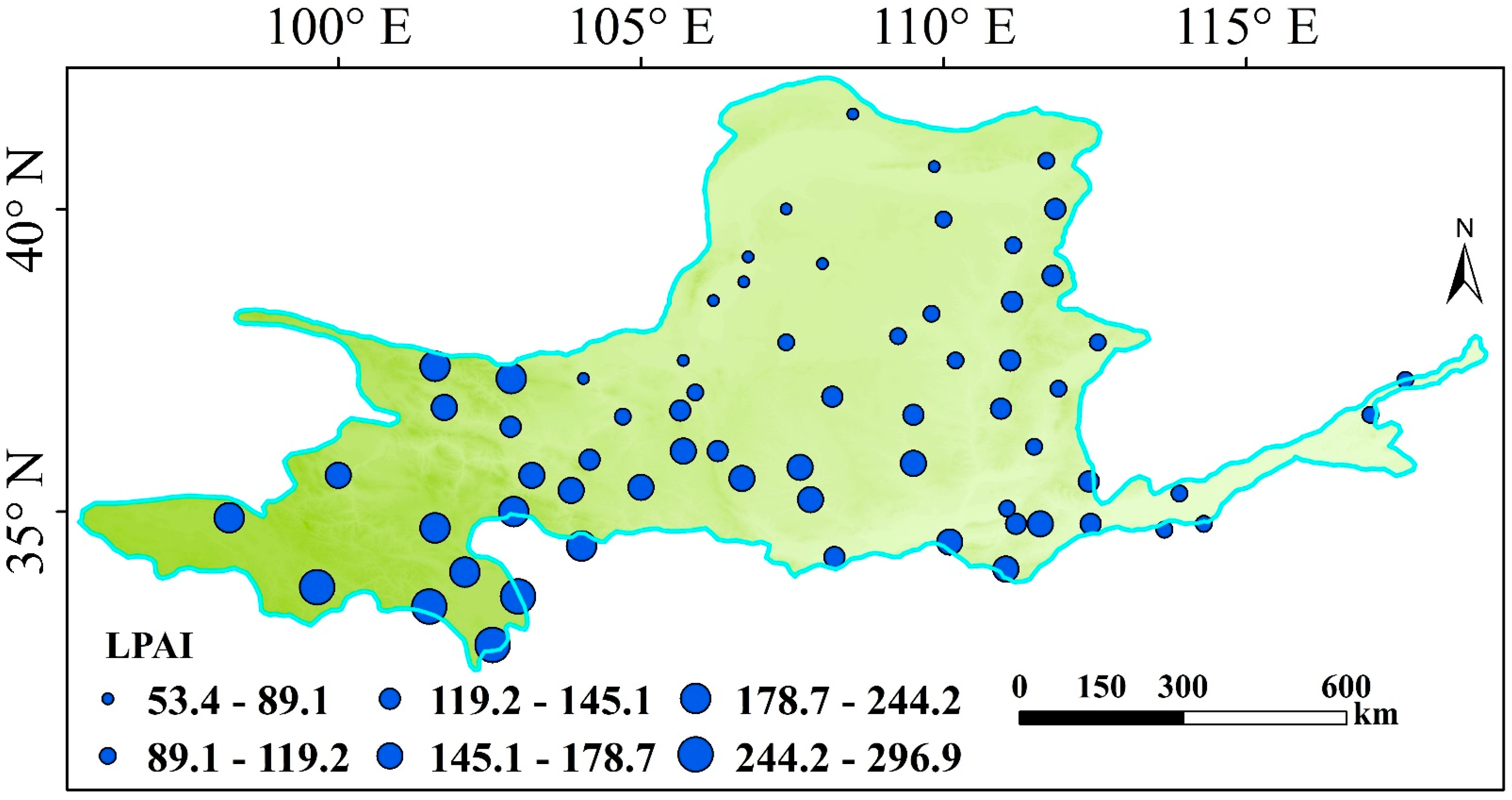
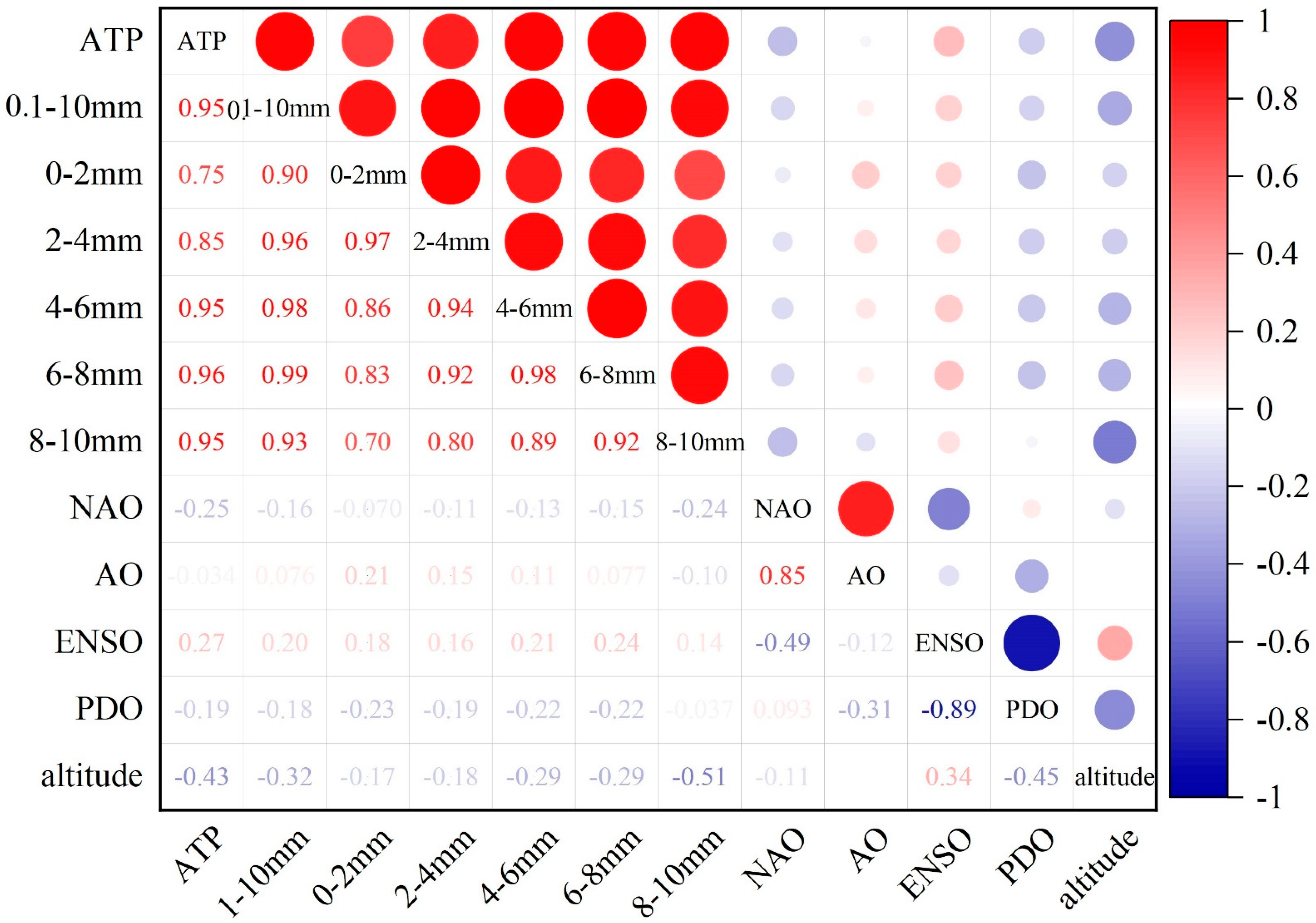
| Grade | Abrupt Change Year | Before Abrupt Change | After Abrupt Change | Differences of the before and after Abrupt Change |
|---|---|---|---|---|
| G1 | 1988 | 31.8 | 30.5 | 1.3 |
| G2 | 1978 | 42.1 | 39.8 | 2.4 |
| G3 | 1986 | 40.6 | 39.3 | 1.3 |
| G4 | 1970 | 39.1 | 37.0 | 2.1 |
| G5 | 1987 | 34.2 | 33.7 | 0.5 |
Publisher’s Note: MDPI stays neutral with regard to jurisdictional claims in published maps and institutional affiliations. |
© 2022 by the authors. Licensee MDPI, Basel, Switzerland. This article is an open access article distributed under the terms and conditions of the Creative Commons Attribution (CC BY) license (https://creativecommons.org/licenses/by/4.0/).
Share and Cite
Zhang, K.; Ji, Y.; Peng, J.; Zhang, H. Spatiotemporal Variations in Light Precipitation Events in the Yellow River Basin, China, and Relationships with Large-Scale Atmospheric Circulation Patterns. Sustainability 2022, 14, 6969. https://doi.org/10.3390/su14126969
Zhang K, Ji Y, Peng J, Zhang H. Spatiotemporal Variations in Light Precipitation Events in the Yellow River Basin, China, and Relationships with Large-Scale Atmospheric Circulation Patterns. Sustainability. 2022; 14(12):6969. https://doi.org/10.3390/su14126969
Chicago/Turabian StyleZhang, Kexin, Yan Ji, Jiaoting Peng, and Hongchang Zhang. 2022. "Spatiotemporal Variations in Light Precipitation Events in the Yellow River Basin, China, and Relationships with Large-Scale Atmospheric Circulation Patterns" Sustainability 14, no. 12: 6969. https://doi.org/10.3390/su14126969





